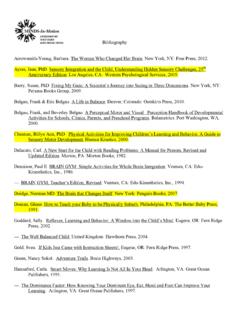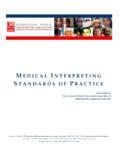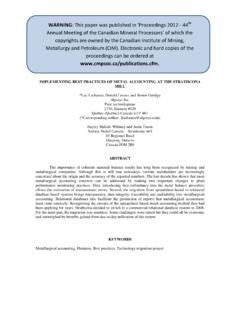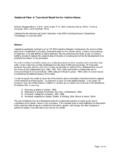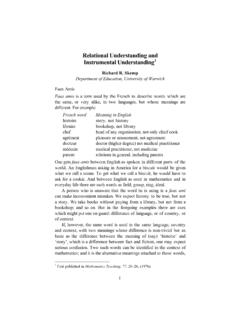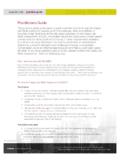Transcription of Reflective Practice for Supervisors 2016 HANDOUT …
1 2/22/20161 Reflective Practice : Skills for SupervisorsAngela M. Tomlin, PhD, HSPP, IMH E (IV)Indiana University School of MedicineRiley Hospital for Children at IU HealthObjectives Define Reflective Practice and Reflective supervision and discuss evidence of effectiveness Identify roles of the Reflective supervisor in early care settings Delineate the structure of a Reflective supervision session Identify and Practice Reflective supervision strategies that support staffTomlin, 2016 Agenda Defining and Connecting: Reflection, Reflective Practice and Reflective Supervision Why Reflection Matters Structure of RS Sessions: What We Do and When We Do It Break How to BE a Reflective supervisor .
2 Skills and Strategies to Try DVD Example and Discussion Self Reflection: My Personal Strengths and Needs as a Reflective SupervisorTomlin, 20162/22/20162 Some terms we Reflective Functioning Reflection Reflective Practice Reflective SupervisionTomlin, 2016 Reflective Functioning A human mental capacity. The ability to recognize mental states (feelings, intentions, beliefs) in yourself and others and to linkthem to behaviors. Has meaning making purpose: I/She/He did this behavior/action because of this feeling, want, , 2016 Reflective Functioning Innate capacity Grown through social experiences RF may underpin parent s ability to take a child s perspective, wonder about child s experienceTomlin, 20162/22/20163 Reflection Stepping back from the immediate, intensive experience of hands on work and taking the time to wonderwhat the experience really means.
3 (Parlarkian, 2001)Tomlin, 2016 Reflection is most possible when we: Have dedicated time Slow down Suspend certaintyTomlin, 2016 Reflective Practice Able to examine one s thoughts and feelings related to professional and personal responses within the infant and family field. (MI AIMH) A process of carefully considering the qualities and characteristics of one s ideas and /or actions that goes beyond the simple application of professional knowledge (Schon in Summers & Chazan Cohen, 2012). Tomlin, 20162/22/20164 Why Reflective Practice MattersReflection builds relationships promotes self regulation, problem solving capacity promotes learning, self awareness and personal growth builds skills way of being, specific strategies provides Self Care Reduce burn out and provider turn over.
4 Vicarious traumaTomlin, 2016In Reflective Practice we: Think differently so we can act differently Apply knowledge and skills Integrate in a meaningful way new knowledge and strategies (Gatti & Watson, 2011)Tomlin, 2016 Reflective Supervision/Consultation A collaborative partnership for professional growth that improves program quality and Practice by cherishing strengths and partnering around vulnerabilities to generate growth. (Shahmoon Shanok, 1991). Or more, simply, a relationship for learning Tomlin, 20162/22/20165 The Reflective Supervisory Relationship is consistently structured, shown by: Regularity Collaborative Partnership Reflection (Emily Fenichel)Tomlin, 2016 The supervisor is safe and containing, shown by: Clear Communication/Honesty Dependability Respectful and Confidential with information CompassionateTomlin, 2016 Relationship based Practice Values early developing relationships between parents and young children as the foundation for optimal growth and change; directs all services to nurture early developing relationships within families.
5 Values the working relationship between parents and professionals as the instrument for therapeutic change; values all relationship experiences, past and present, as significant to one s capacity to nurture and support others. (MI AIMH)Tomlin, 20162/22 the medium through which intervention is delivered change occurs through the quality of interaction (KadijaJohnston)Tomlin, 2016 Parallel Process:Relationships in Early Childhood WorkParent ChildProfessional ParentSupervisor ProfessionalTomlin, 2016 Why is RS Needed?Professional Development/Skill building/Ethical Practice Builds bridge from knowledge to applied skills Helps providers think more broadly; enhances Practice Improves Service: Helps providers stay grounded; avoid being overwhelmed by the needs of the family, child Clarifies boundaries of work; scope of Practice Lets us use emotion and cognition without overdoing either one Supports providers to reduce burn out, turnover so they can support familiesTomlin, 20162/22/20167 Does RS Work?
6 What evidence do we have? In general, good evidence that PRF is connected to child outcomes Allows for self exploration, insight (Forstadt, 2012; Virmani & Ontai, 2010 Weatherston & Barron, 2009) Skill building, new ideas (Forstadt, 2012; Watson, et al. 2014) Results in higher quality service (Heffron, 2005;Watson, et al., 2014) Reduce stress, improve thinking (Watson, et al., 2014) Increase in positive interactions with child (Virmani, et al. 2013) Increase in job satisfaction (Forstadt, 2012) Reduction in expulsion of young children (Gilliam & Shahar, 2006)Tomlin, 2016 What happens in RS Session?The supervisor and the supervisee work together in shared activities, including: Noticing: Observe, Listen, Focusing Attention Wondering: Being Curious, Suspending Judgment and Certainty Responding: Thinking and Feeling Reflecting: Slowing Down, Attending to experience of oneself and others(Weatherston)Tomlin, 2016 Sample FormatsExample 1: Greeting and checking on immediate needs Observing the supervisee s general mood and tone Recapping discussion from last session Jointly set agenda Closing and Plan for next meeting (Heffron & Murch, 2011)Example 2.
7 Preparation Greeting/reconnecting Opening the dialogue/finding the agenda Telling the story/focusing on the details Understanding perspectives/generating hypotheses Considering next steps Closing and post supervision reflection (Gilkerson & Shamoon Shanok, 2000)Tomlin, 20162/22/20168 Break!See you back in 15 minutesTomlin, 2016 Five KEY ROLES for Reflective Supervisors (Heffron & Murch, 2010) Support staff member s development. Provide a secure base where staff can safely explore the meaning of their work. Maintaining program ideals and standards, quality assurance, and safety. Facilitating open communication and effective team functioning. Providing program , 2016 Video Example and DiscussionMore skills to watch for: listen carefully demonstrate concern and empathy promote reflection observe and highlight the parent/child relationship respect role boundaries respond thoughtfully in emotionally intense interactions understand, regulate, and use one s own feelings(Gilkerson & Taylor Ritzler, 2005)Tomlin, 20162/22/20169 Getting Started with a Supervisee(Heffron & Murch, 2010) Explore past experiences with supervision what worked, what did not?
8 Talk about how feedback will be given Be clear about differences invite discussion Establish expectations logistics about meetings, preparation for meetings, confidentiality Explain what supervision will be like! Model collaborationTomlin, 2016 Thoughts about Supervisee Feelings(Heller and Gilkerson, 2010) supervisor supports to increase awareness of one s own internal states and triggers What s going on inside you? What s being stirred up as you hear this story, situation What was your temperature as this situation happened? supervisor responses to modulate strong feelings of supervisee/group I d like to hear more about how being with this family is for you I can tell you feel deeply about this work.
9 Where might these feelings come from?Tomlin, 2016 Evaluating RS/RC Rating scales Superviser Supervisee Research RIOST omlin, 20162/22/201610 Next Steps: My Plan for Future Learning What questions do you still have about reflection, Reflective Practice and supervision?What specific strategies or concepts from this discussion about reflection, Reflective Practice , and Reflective supervision were most helpful to you? Think about the skills discussed today that underlie Reflective Practice which are strongest for you? Which skills do you feel you need to enhance? How will you apply what has been learned in your daily work? What do you need knowledge, resources, other supports to implement strategies discussed today?
10 What kind of learning methods would you prefer reading, DVD, additional face to face training, Reflective supervision/mentoring experiences?Tomlin, 2016 Questions 2016 Reading List/References Eggbeer, L., Shahmoon Shanok, R., & Clark, R. (2010). Reaching toward an evidence base for Reflective to Three, 31(2), 39 50. Heffron, M. C. & Murch, T. (2010). Reflective supervision and leadership in early childhood , DC: Zero to Three Press. Heller, S. & Gilkerson, L. (Eds.). A practical guide to Reflective supervision. Washington, : Zero to Three Press, 61 80. Neilsen Gatti, S., Watson, C. & Siegel, C. (2011). Step back and consider: Learning from Reflective Practice in infant mental health, Young Exceptional Children, 14 (2), 32 45.



